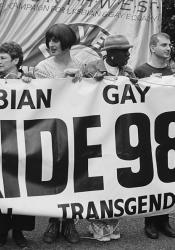Section 28 of the Local Government Act 1988 is Enacted in the UK
Section 28 of the Local Government Act 1988 was enacted by Margaret Thatcher, former Prime Minister, and her conservative government in the UK on May 24, 1988. It amends Part II of the Local Government Act 1986, which dealt with local authority publicity. Section 28 states that local authorities cannot “intentionally promote homosexuality or public material with the intention of promoting homosexuality” or “promote the teaching in any maintained school of the acceptability of homosexuality as a pretended family relationship,” (Macnair 35). This resulted in the stigmatization and discrimination of LGBTQ+ people.
Section 28 came into effect due to multiple events during the time. It was partly caused by the growing AIDS crisis in the UK (Moran 76). In the beginning of the 1980s, cases of HIV and AIDS started rising rapidly (primarily in gay men, drug users, immigrants, and racial minorities), resulting in numerous deaths. Eventually, the disease became mainly associated with gay men, leading to extreme fear and homophobia. The creation of Section 28 was also partially due to political conflict between left-wing local authorities and the right-wing national government (Greenland 243). The media helped to incite concern and panic in people that Section 28 was created to address (Greenland 243). The media spread stories of books or videos being distributed in schools that were deemed inappropriate for children. One of the most discussed books was Jenny lives with Eric and Martin. This was a children’s book about a girl who lived with her father and his male partner. Some people were worried that it would encourage children to “become” gay or force them to learn about gay sex (Greenland 244). The public concerns spiraled and grew, forcing the UK government to introduce Section 28.
The enactment of Section 28 had major effects on the UK and its people. One positive effect of the introduction of Section 28 was that it permanently put LGBTQ+ issues on a national stage for discussion (Greenland 244). In schools, however, the effects were mainly negative. In schools, there was large-scale uncertainty about what kind of behaviors were deemed illegal by Section 28. While no local authority was ever officially prosecuted, Section 28 still caused widespread confusion and fear. This led many teachers to completely exclude LGBTQ+ issues from the classroom, resulting in an increase of homophobic bullying (Greenland 245). Many teachers reported that it made meeting the needs of LGBTQ+ students very difficult (Greenland 244). Teachers were also worried that being open about their own sexuality would result in them being fired (Lee 676). Inside and outside of schools, LGBTQ+ people and their allies were horrified by the implication of Section 28, and many participated in protests, rallies, and advocacy aimed at repealing Section 28 (as seen in Manchester in 1988). In general, the effects of Section 28 on education and on the LGBTQ+ community were extensive. Even after it was repealed in England in 2003, Section 28 still affects LGBTQ+ teachers and students in schools thirty years later (Lee 675). Macnair describes, “The indirect effects will go deeper and last longer,” (38). However, great progress has been made to reverse those negative effects of Section 28 and improve LGBTQ+ rights and inclusion in the UK.
Works Cited
Greenland, Katy, and Rosalind Nunney. “The Repeal of Section 28: It Ain’t over ‘Til It’s Over.” Pastoral care in education 26.4 (2008): 243–251. Web.
Lee, Catherine. “Fifteen Years on: The Legacy of Section 28 for LGBT+ Teachers in English Schools.” Sex education 19.6 (2019): 675–690. Web.
Macnair, M R T. “Homosexuality in Schools - Section 28 Local Government Act 1988.” Education and the law 1.1 (1989): 35–39. Web.
Moran, Joe. “Childhood Sexuality and Education: The Case of Section 28.” Sexualities 4.1 (2001): 73–89. Web.

